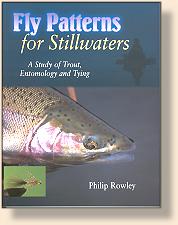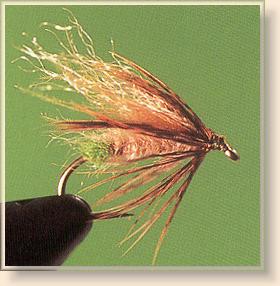|
Diving Caddis
In many still-water anglers' fly boxes diving caddis patterns
tend to be conspicuous by their absence. And for a long time my fly
boxes were devoid of these patterns too. The first time I ran across
trout feeding on diving female caddis I mistook what I saw as a
hatch. About 2:00 in the afternoon cinnamon sedges appeared
everywhere, all over the water's surface, in my boat and even up
the base of my neck. Trout rolled and slashed at the surface.
Maintaining my discipline, I surveyed the surface for pupal shucks
but pupal shucks were nonexistent. I studied the rise forms to help
determine if the fish were feeding subsurface or not. Then I saw
an adult caddis pop from the water and fly away. This was further
confirmation on my initial diagnosis, or so I thought. Deciding on a
small size 12 soft-hackle papa pattern, I began working the water
furiously. After what seemed an eternity of casting I latched onto a
decent fish. Upon landing the fish I pumped its stomach for
confirmation of my diagnosis. The pump revealed adult caddis.
This confused me as I had pounded the water with a dry prior to
using the soft hackle pattern. Looking closer I noticed a prominent
green egg sack at the rear of the abdomen. At last the gears clicked
into place and I realized that the trout were boiling and feeding
upon egg-laying females plunging into the lake to deposit their eggs.
Since I had no diving caddis patterns in my box I continued using
the pupa pattern hoping I could fool more fish. I did not. But I
learned a valuable lesson about egg-laying caddis behavior and the
need to carry a decent diving caddis pattern. I chastised myself, as
I knew about female caddis laying their eggs beneath the surface.
In some naive state I linked this behavior to rivers and streams,
never considering lakes. I vowed not to repeat this mistake again.
Materials
Hook: Tiemco 3769, #10 - #16.
Thread: Tan or olive 8/0.
Butt: Bright green or lime dubbing.
Body: LaFontaine Touch Dubbing mix in
shades of green, olive or brown.
Thorax: Peacock-coloured dubbing.
Underwing: Mixture of soft hackle and matching CDC fibers.
Overwing: Clear Antron fibers.
Hackle: Grouse, partridge or mottled hen saddle.
Tying Steps:

1. Cover the hook shank with tying thread. Form the butt
by dubbing a small ball of bright green or lime dubbing.

2. Pull down a length of tying thread. Dab a sparse coat of
dubbing wax. Take the dubbing mix and touch it lightly to
the tying thread. Pinch the dubbing noodle between the thumb
and fore finger to flatten its appearance. Wind the dubbing
forward to form the body. The finished body should occupy
4/5 of the hook shank.

3. Tie in a clump of soft-hackle fibers followed by an additional
clump of matching CDC fibers. Be careful not to overdress the wing.

4. Tie in the clear antron overwing.

5. Wrap a sparse hackle to complete the fly. Trim any
excess material. Build a neat head. Whip-finish and
apply head cement
How to fish the Diving Caddis:
The Diving Caddis is designed to imitate the egg-laying females of the Caddis family Leptroceridae.
This lesser known caddis family is present in many stillwaters throughout North America. Females
from this family differ from other caddis in that they dive beneath the water's surface depositing their
egg clusters directly upon submergent vegetation and debris. Encased in a shiny bubble of air these
energetic adults scull down to the bottom to transfer their precious cargo. Once unloaded they bob
and paddle their way back up to the surface. This trek does not go unnoticed by opportunistic trout.
At first glance trout taking adults as they enter or leave the water gives the illusion of an emergence.
Casting dry or emerger patterns at this time is one of the most frustrating experiences available to the
fly fisher. Watch for adults diving into the lake and scan the water for pupal shucks, if non are present
chances are trout are focused upon egg laying females. Try to catch one of the adults and look for the
distinct egg cluster at the rear of their abdomen. This is not usually a hard exercise as the adults appear
out of now where smothering the boat and the angler throughout the egg laying process.

To fish the Diving Caddis use either a floating or intermediate fly line depending upon conditions.
If the water is calm and clear the floating line can disturb the surface during the retrieve spooking
trout in the process. The intermediate line cuts through the surface masking its presence but does
not sink fast enough to overpower the presentation. Keep the leaders long, typically fifteen feet or
longer for floating lines and about nine to twelve feet for intermediates. Water depth and clarity are
typical deciding factors, the clearer the water the longer and finer the leader. Make a cast, preferably
amongst a pod of visibly feed trout, and allow the pattern to sink to the bottom. Weighting the head
of the fly helps simulate the nose down diving attitude of the natural females. Once the fly is on or
near the bottom begin a slow four-inch strip pause retrieve bringing the fly back up towards the
surface. The pause between the strips simulates the insect resting between strokes. Expect a
take anywhere throughout the retrieve and be alert for takes on the drop. Putting the rod down
after the cast to grab a drink or a sandwich could prove to be an exciting even traumatic experience.
~ Phillip Rowley
Credits: From the terrific new book Fly Patterns for Stillwaters published by Frank Amato Publications. We greatly appreciate use permission.
For more great flies, check out:
Beginning Fly Tying,
Intermediate Fly Tying and Advanced
Fly Tying.
|







